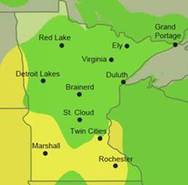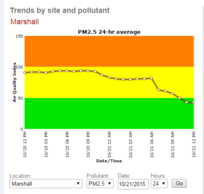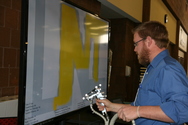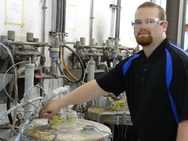In this issue:
New online air
quality permitting services available
Beginning October 6th, 2015, you can electronically apply
for an administrative amendment to extend a deadline up to 120 days or to
change ownership, facility name, or owner or operator name. To use these
services, go to the MPCA's e-Services
webpage.
Please note:
Users of this service are currently experiencing problems with Chrome and
Firefox browsers. While we work to resolve the problem, please use Internet
Explorer (version 9 or 10) for the best results.
If you have questions or comments, please send us a note.
Final Clean Power
Plan Released
Final emission standards for existing power plants, commonly
called the Clean Power Plan, were published in the Federal Register on Friday,
October 23, 2015. Included with the Clean Power Plan (80 FR
64662) was a proposed federal rule that would be imposed on states that
fail to submit their own plans and model trading rules that states would be
able to choose to adopt as part of their compliance plans (80 FR 64966),
as well as final standards of performance for new and modified power plants (80 FR
64510).
The MPCA has begun our stakeholder process to learn what
people around the state think is most important in the development of our state
compliance plan. On October 8 we held a meeting to hear reactions of
stakeholders to the final EPA plan. We are also developing a plan for
outreach specifically to communities of environmental justice concern. The
MPCA will conduct an analysis to identify any possible disproportionate
negative impacts on communities of environmental justice concern around
Minnesota. This analysis will be shared with the public and will help us
develop a plan that will benefit all Minnesotans. We are in the beginning stages of planning
meetings and events around the state to share information and hear the
interests and concerns of people living outside of the Twin Cities metro area.
For more information on the Clean Power Plan, visit EPA’s webpage. For more
information on the MPCA’s efforts to develop Minnesota’s compliance plan, visit
the MPCA’s website.
There you can also find information from previous technical stakeholder
meetings.
EPA releases final
ozone standard
In October the U.S. Environmental Protection Agency (EPA)
announced a new ground-level ozone standard of 70 parts per billion (ppb), lowering
it from 75 ppb. Based on preliminary 2015 monitoring data, all monitors
in Minnesota are able to meet the standard. Currently, the highest ozone
monitors in Minnesota are at 65 ppb and are located in Blaine and
Marshall. The MPCA recently launched a new ozone
standard webpage where you can find out more about ozone in Minnesota
and how we are doing compared to the national standards.
For more information on ozone, visit the MPCA’s new
interactive ozone webpage.
The fact that we are currently under the standard doesn’t
mean our work is done, though. We are still very close to the standard
and if ozone levels go up – even if due to weather – we could be in violation
of the standard. We may also have responsibilities to lower our emissions
to help our neighboring states come into compliance with the standard.
EPA must review the ozone standard every five years; in
recent years they have been finding health impacts at lower and lower
concentrations of the pollutant, resulting in a lower and lower standard.
In order to continue to protect the health of all Minnesotans and comply with
current and future national standards, we will need to continue to seek voluntary
reductions in the emissions that cause ozone. We at the MPCA look forward
to continuing to work with our partners in Clean Air Minnesota and beyond to
continue this important work.
Please visit our website for more information on the new ozone
standard and what it means for Minnesotans. For more information on air
pollution and its impacts on Minnesotans’ health, visit BeAirAwareMN.org.
 Replacing two engines
will cut a half-ton of particulate matter
Big, older diesel engines
emit a lot of pollution; so much that, in terms of reducing air pollution,
changing even one of them to a newer, cleaner-burning model can be like taking
thousands of cars off the road.
That’s why the Minnesota
Pollution Control Agency (MPCA) offers grants to help operators of heavy
diesel-powered equipment replace or retrofit their smoky old engines. Diesels
are strong and tough and can last for decades. MPCA’s Clean Diesel Grants help
give fleet operators an extra incentive to get rid of older engines that still
work fine, but spew a lot of pollutants.
|
 On September 23, Environmental Initiatives (EI), a Project
Green Fleet partner, held a news conference to announce its plans to help cut
more than half a ton of fine-particle (PM2.5) emissions per year by
replacing the engines in a 56-foot towboat called the Becky Sue, owned by Upper River Services in St. Paul.
The news conference included St. Paul Mayor Chris Coleman
and MPCA Assistant Commissioner David Thornton.
The grant project will replace two 17-year-old diesel engines with two
new Caterpillar diesels that meet the EPA’s new, stringent Tier 3 emission
standards. Replacing these two engines
will reduce an estimated 1,380 pounds of PM2.5 per year. That’s the equivalent of taking 12,000 cars
off the road!
EI used $90,000 in funding from Flint Hills Resources, a
partner in Project Green Fleet and Clean Air Minnesota, to cover the 25 percent
grant portion of the $360,000 upgrade.
Upper River Services funded the other 75 percent. The project should be
completed by early November.
To learn more about the Becky Sue project, visit our website. See the article below or visit the MPCA’s Clean Diesel Grant webpage
for information on opportunities for funding to replace and retrofit old diesel
vehicles.
|

Big, old diesel engines emit disproportionately high amounts
of particulate pollution (see Becky Sue
article for more information). For that
reason, cleaning up these engines remains a prime target in the state and a
priority for the MPCA and its partners.
That’s why the MPCA will offer $270,000 in grants in November or
December to help operators of heavy diesel-powered equipment replace or
retrofit smoky old engines. MPCA’s Clean
Diesel Grants help give fleet operators extra incentive to get rid of older
engines that still work, but spew a lot of pollutants.
Thanks to a 2014 MPCA grant, Highland Sanitation was able to
replace two old garbage trucks with new ones. Co-owner Sue Steward said, “The
trucks are working fabulous! And our
maintenance expense went down last year, which was great in helping to pay for
the new trucks.”
Look for more news soon, or go to our Clean Diesel Grants website
for more information.
|

People who are sensitive to the effects of air pollution may
not always know it. They know when they
feel sick, but they might not realize that air quality can have something to do
with it. A “bad air day” is one where
air pollution can make people sick, and one of the best ways to know if we’re
having such a day is to check the Air
Quality Index (AQI), which provides real-time air
quality information.
A group of major Twin Cities companies is helping to spread
awareness among their employees about the AQI by becoming “Air Aware
Employers.” This program started as an
initiative of Clean Air Minnesota to raise awareness of steps people and
businesses can take to help reduce the impact of bad air days. Employers who sign on to participate, pledge
to notify their employees when air quality in the Twin Cities metro reaches AQI
levels designated “unhealthy for sensitive groups” or worse. They can also encourage their employees to
take personal actions that can improve air quality, such as using mass transit
regularly, minimizing use of gas-powered lawn equipment, or burning wood during
air alerts. By participating in this
voluntary program, employers can get information for use in newsletters and
other wellness messaging to help keep Minnesota’s air clean.
The Air Aware Employer program has seen a big boost in
sign-ups since it’s been featured on a Twin Cities website called Move Minneapolis. This group has a campaign called Breathe EZ MPLS that aims to improve
air quality in the Twin Cities, and as part of that effort, Move Minneapolis
recently garnered pledges from four large local employers. These pledges represent more than 20,000
people whose employers are now sharing with them information about the
connection between air quality and health, and what to do about it.
For more information on how to take the Air Aware Pledge and
become an Air Aware Employer, visit The Air Aware Employer page
at BeAirAwareMN.org.
|
On August 24, EPA determined that Minnesota’s only
nonattainment area is officially complying with the National Ambient Air
Quality Standards (NAAQS) for lead.
Nonattainment areas are areas of the country that do not comply with the
NAAQS for a certain pollutant and are therefore under certain restrictions
meant to bring the area into compliance.
Minnesota’s only nonattainment area currently is an area surrounding
Gopher Resource, LLC in Eagan which was found to be exceeding the 2008 NAAQS for
lead when that new, more stringent standard was released. The facility implemented emissions controls
and monitoring of the area has been showing compliance with the standard since
2012. The MPCA submitted to EPA
complete, quality-assured, and certified ambient air monitoring data for the
2012-2014 period, demonstrating the required three years of attainment.
An attainment determination is a precursor to a formal
redesignation of the area, and it suspends certain planning requirements for
the state and facility as long as the area continues to attain the standard. All
current emissions controls will be maintained.
Before the area is officially redesignated to attainment by EPA, the
MPCA will submit a maintenance plan showing how it intends to ensure long-term
compliance with the NAAQS. Read the full
determination in the Federal
Register (80 FR 51127).

On October 20, 2015 an Air Quality Advisory was issued for
parts of southwestern and south central Minnesota as fine particulate pollution
reached a level deemed unhealthy for sensitive groups. These groups include the
elderly, children, those with cardiovascular or respiratory disease, and people
who are participating in activities requiring heavy exertion. The affected area
included Marshall, Redwood Falls, New Ulm, and Hutchinson. A combination of
active crop harvesting in full force due to the nice weather, a persistent dry
pattern, and a stationary frontal boundary trapping air in its vicinity all
contributed to the increase in Air Quality Index (AQI) measures. The event
lasted approximately 10-12 hours before a cold front moved into the area ushering in stronger westerly winds and scattered rain showers which helped to
disperse the particulates in the air.
|
|
For more information on the air pollution advisory, potential
health impacts from elevated levels of fine particles, and pollution-reduction
tips visit the MPCA website. For more information about air quality and
health, visit BeAirAwareMN.org. To
receive daily air quality forecasts and air quality alert notifications by
email or text message, sign up on the Enviroflash
webpage.
|
|
 |

MnTAP launches E3 in
Industrial Painting Project – apply now!
The University of Minnesota’s Minnesota Technical Assistance
Program (MnTAP) is bringing the E3 technical assistance program to Minnesota
businesses with painting and coating operations. E3 stands for Economy, Energy, and
Environment. It’s a program meant to maximize efficiency and help businesses be
more competitive by using energy and waste assessments in combination with
“Lean Tools,” which focus on eliminating waste while maximizing value. Learn more about Lean Tools here.
A limited number of openings are available for this project.
Companies will be selected based on potential waste and energy savings and
demonstrated commitment to implementing recommendations. Applications will be
accepted until all project slots are filled. To apply, click here. For more information contact Paul Pagel at ppagel@umn.edu or 612-624-4638.
|

Improve transfer
efficiency by attending painter training
The Twin Cities Chemical Coaters Association (CCAI) and
MnTAP are hosting a four-hour spray painting-technique training session for
industrial painting operations using virtual application technology. Expert
trainers from the Iowa Waste Reduction Center at the University of Northern
Iowa will be providing experienced, hands-on training using a state-of-the-art
virtual technology that allows for realistic, instantaneous feedback on
technique and materials use for either wood or metal industrial liquid-painting
applications.
The class will be held on December 22, 2015, starting at 8
a.m. at the Steele County Administration Building in Owatonna, Minnesota. The cost
is $25 for CCAI members and $35 for non-members; lunch is included with
registration. For more information, click here.
To register, click here.
|

An extra set of eyes:
MnTAP interns identify opportunities, solutions, and savings
MnTAP is currently seeking project proposals from Minnesota
businesses for its 2016 summer intern program. Businesses interested in
reducing waste, conserving water, and improving energy efficiency are encouraged
to apply for an intern in 2016. Proposed projects are evaluated for impact
potential, project scope, and company interest and commitment. Interns are
chosen based on their educational backgrounds and leadership capabilities.
MnTAP anticipates supporting up to 15 projects this summer,
with at least one project focused on paint efficiency and at least three others
focusing on water conservation. Other projects will focus on source reduction,
energy efficiency, and pollution prevention. Applications are open now until
February 1, 2016 and will be reviewed upon receipt. Apply online here. If you work with Minnesota companies, please
spread the word to those companies you think might be a good fit for this
opportunity. Find out more at MnTAP’s
intern page, or call MnTAP at 612-624-1300 to participate.
|

Tobacco is the number one
preventable cause of death in Minnesota and in the U.S. generally. It affects not only smokers themselves but
also families, coworkers, and anyone else who breathes second-hand smoke. Every November the American
Cancer Society Great American Smokeout encourages the millions of Americans
who still smoke to kick the habit. This year’s Great American Smokeout is November
19.
An article about the smokeout
is featured this month on BeAirAwareMN.org.
This new website, a joint product of the Minnesota Department of Health (MDH)
and the MPCA, aims to be a one-stop shop for all things air quality. The site provides information on the
connection between air quality and health in an easily accessible manner.
BeAirAwareMN.org is for residents,
employers, local governments, schools, and anyone else with a stake in the
quality of the indoor and outdoor air we all breathe – in other words,
everyone! The MDH and MPCA are working
to spread awareness of BeAirAwareMN.org and we encourage Air Mail readers to
give it a look. If your organization is
interested in becoming a partner in growing “Air Awareness,” contact Ralph
Pribble at ralph.pribble@state.mn.us
or 651-757-2657.
|
The Community Air Monitoring Project (CAMP) is currently
monitoring air quality in Duluth. Using and supplementing two existing
Duluth air monitoring sites, air quality is being monitored in the Denfeld,
Oneota, and Lincoln Park community areas. Each monitor will measure
common air pollutants, such as fine particles (dust and soot), volatile organic
compounds, and metals, which can negatively impact our health when we breathe
them in. Monitoring will began July 1, 2015 and will run to December 31,
2015.
The Community Air Monitoring Project uses funding from the
Minnesota Legislature to do short-term ambient air-quality
monitoring in selected Minnesota neighborhoods. The objective is to
monitor and assess air quality in low-income communities or communities of
color that are disproportionately impacted by air pollution emissions from
highways, air traffic, or industrial sources. Since starting this
community project in October 2013, the MPCA has completed monitoring at seven other
neighborhood sites.
After the monitoring is completed, MPCA staff will analyze
results, post the results to the CAMP
website, and share the findings with
the public. For more information on the
community air monitoring project, please visit the CAMP website or call either
651-296-6300 or 1-800-657-3864 and ask for air data analysis staff. More
information about the MPCA’s air monitoring program is available on the MPCA’s website.
The 30th Annual Conference on the Environment
hosted by the Central States Water Environment
Association and the Air and Waste
Management Association will be held on November 4 at the Minneapolis
Convention Center. This year’s theme is
“Innovation and Collaboration, the Keys to the Future.” The keynote address will be given by
Minneapolis City Council Members Elizabeth Glidden and Cam Gordon on the city’s
Clean Energy Partnership and other environmental initiatives. This is a great event for environmental
professionals to keep up-to-date on the most current environmental issues. For the conference agenda and to register for
this popular event, click here.
Volkswagen emissions
scandal
EPA issued a notice of violation of the Clean Air Act to
Volkswagen on September 18. The notice
alleges that Volkswagen and Audi diesel cars from model years 2009-2015 include
“defeat devices” that allowed the cars to emit more pollutants than allowed by
the Clean Air Act. The defeat device in
these vehicles is a piece of software that can detect when emissions tests are
occurring on the vehicle and switch on emissions controls, then switch them
back off during normal operation of the vehicle. The defeat device results in emissions of
nitrogen oxides that are 10-40 times higher than emissions standards. A recent
study by MIT and Harvard researchers indicates that affected vehicles will
contribute to 60 premature deaths due to the excess emissions. The EPA’s investigation is ongoing and
details on recalls or other actions are yet to come. For more information on the violation, visit EPA’s website. For another perspective of what it all means,
check out this article
by the Guardian.
Air Mail is a quarterly,
email-based newsletter featuring updates on air quality issues and the work of
the MPCA and our partners. Subscribers to this list also receive Air Mail
Bulletins, which provide time-sensitive regulatory and technical updates.
To see past issues, Air Mail
Bulletins, or to subscribe, visit the MPCA's website.
If you have questions
or comments about Air Mail, please feel free to contact Amanda Jarrett Smith at
amanda.smith@state.mn.us.
|











